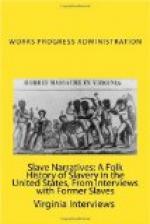“I think a man by the name of Robinson who was in the coal business at Havre de Grace engaged Mr. Davis to tow several barges of soft coal to St. Michaels. It was on July 4th when we arrived at Havre de Grace. Being a holiday, we had to wait until the 5th, before we could start towards St. Michaels.
“Mr. Tuttle, the captain of the tug, did not sleep on the boat that night, but went to a cock fight. The colored men decided to escape and go to Pennsylvania. (I was a small boy). They ran the tug across the bay to Elk Creek, and upon arriving there they beached the tug on the north side, followed a stream that Harriett Tubman had told them about. After traveling about seven miles, they approached a house situated on a large farm which was occupied by one of the deputy sheriffs of the county. The sheriff told them they were under arrest. One of the escaping man seized the sheriff from the rear, after he was thrown they tied him, then they continued on a road towards Pennsylvania. They reached Pennsylvania about dawn. After they had gone some distance in Pennsylvania three men with guns overtook them; but five men and one woman of Pennsylvania with guns and clubs stopped them. In the meantime the sheriff and two of his deputies come up. The sheriff said he had to hold them for the authorities of the county. They were taken by the sheriff from the three men, carried about 15 miles further in Pennsylvania and then were told to go to Chester where they would be safe.
“Mr. Davis came to Chester with Mr. Tuttle to claim the escaping slaves. They were badly beaten, Mr. Tuttle receiving a fractured skull. There were several white men in Chester who were very much interested in colored people, they gave us money to go to Philadelphia. After arriving in Philadelphia, we went to Allen’s mission, a colored church that helped escaping slaves. I stayed in Philadelphia until I was about 19 years old, then all the colored people were free. I returned to Talbot, there remained until 1904, came to Baltimore where I secured a job with James Hitchens, a colored man, who had six furniture vans drawn by two horses each and sometimes by three and four horses. Mr. Hitchens’ office and warehouse were on North Street near Pleasant. I stayed there with Mr. Hitchens until he sold his business to Mr. O. Farror after he had taken sick.
“In March I will be 90 years old. I have been sick three times in my life. I am, and have been a member of North Street Baptist Church for thirty-three years. I am the father of nine children, have been married twice and a grandfather of twenty-three granddaughters and grandsons and forty-five great grand-children.
“While in Philadelphia I attended free school for colored children conducted at Allen’s Mission; when I returned to Talbot county I was in the sixth grade or the sixth reader. Since then I have always been fond of reading. My favored books are the Bible, Bunyan’s Pilgrim’s Progress, Uncle Tom’s Cabin, the lives of Napoleon, Frederick Douglass and Booker T. Washington, and church magazines and the Afro-American.”




